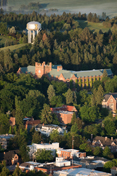StreamLab
Overview
The StreamLab features a large-scale sediment flume to allow fundamental and applied research of processes in headwater streams and mountain rivers with a unique combination of scale, instrumentation, and computer-control.
Capabilities
The flume is 20 meters long, 2 meters wide and 1.2 meters deep. The maximum water discharge is 1.1 cubic meters per second (or 40 cubic feet per second); maximum slope of the flume is 10 percent. A distinguishing feature is the ability to feed sand and gravel in an open circuit (non-recirculating) mode. The flume is designed to be environmentally sensitive. For example, water is recirculated through a large sump and the pumps are lubricated by water rather than oil.
Instrumentation for the flume includes stereoscopic PIV, ADV, optical and acoustic cameras, an optical bed mapping system, and a real-time ultrasonic bed mapping system. Instrumentation may be located anywhere in the flume by a three-axis computer-controlled platform.
Undergraduate Capstone Design Projects
The U of I Senior Capstone Design Program has an outstanding track record in designing equipment for the StreamLab. Recent examples include the design of the sediment trap system and the design of a computer controlled, three axis, instrumentation platform.
Recent Projects
As of 2021 the StreamLab has hosted over 40 sponsored projects from universities, Federal and State agencies, and from regional companies. Recent projects include, "Physical Modeling of a Wave Generating Structure for the Boise River Recreation Park," "Sediment Transport in Mountain Streams," and "Physical Modeling of Hill-slope Erosion,” “Physical Modeling of Modified Culvert Flow to Aid Fish Passage."






